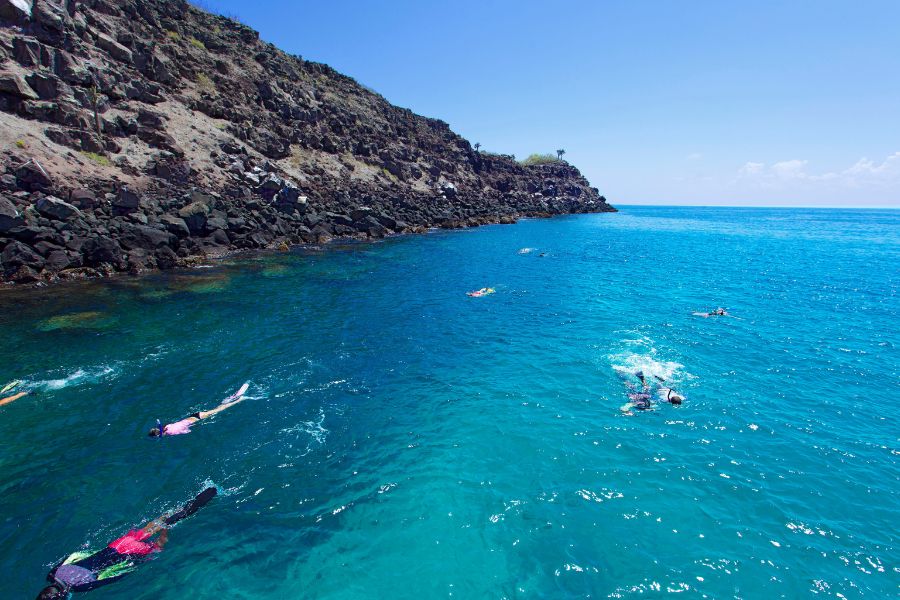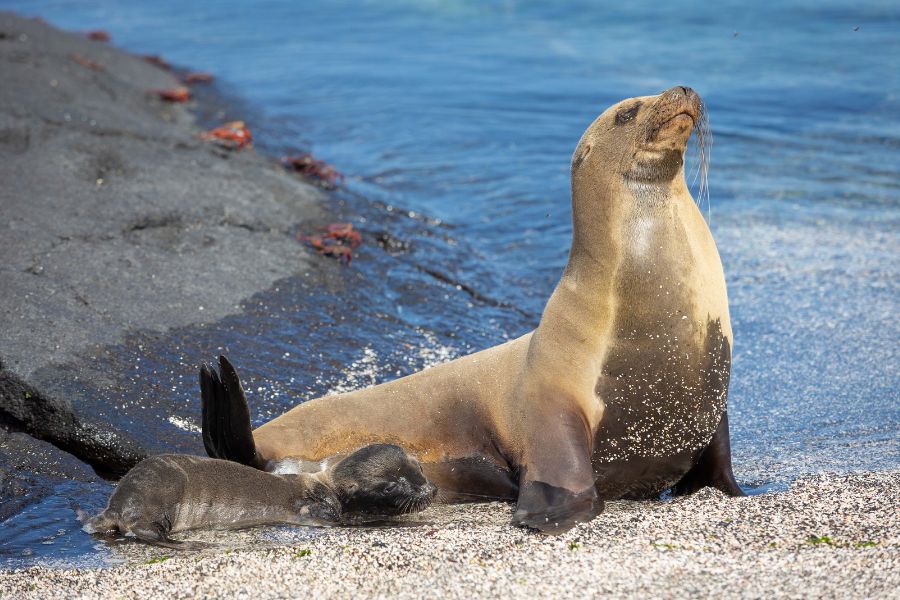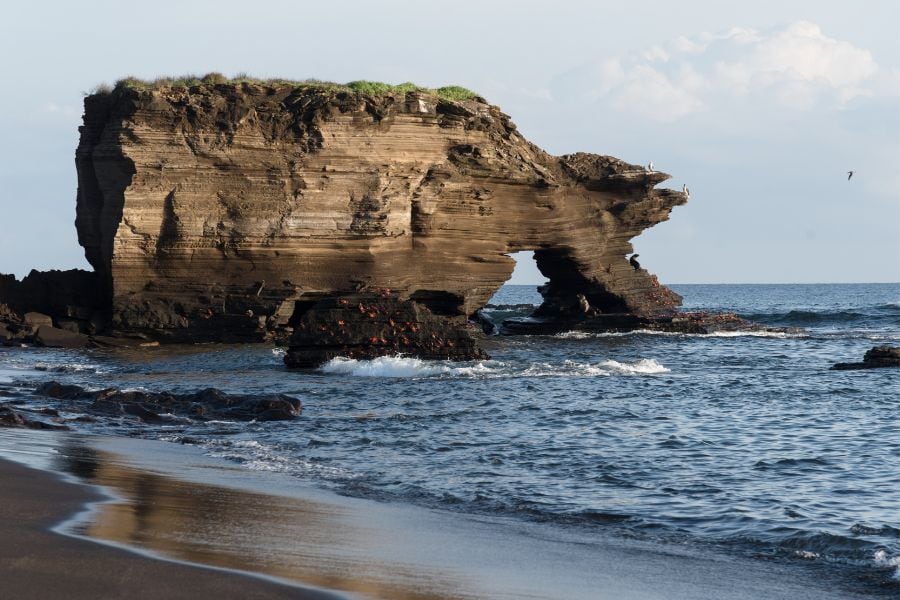
Isabela Island
Located on the western edge of the Galapagos National Park, Isabela Island is the youngest and largest island in the region. With an area of 4,586 square kilometers, it is also larger than all the other islands in the archipelago combined. Originally the island was named Albemarle, after the Duke of Albemarle, one of the first Europeans to set foot in the Galapagos . The name was later changed to honor the Spanish Queen of Castile, Isabella I.
From above, Isla Isabela bears a distinctive seahorse shape which was influenced by the merging of six shield volcanoes: Alcedo, Cerro Azul, Darwin, Ecuador, Sierra Negra, and Wolf — all of which are still active bar Ecuador, making it the most volcanically active place on earth.
Today’s thriving land and marine life populations share the island with the locals, most of whom live on the southern coast in Puerto Villamil. Visitors can expect to meet an exotic array of endemic reptiles, land birds, sea birds, and marine life. Examples include blue-footed boobies, giant tortoises, iguanas, Galapagos penguins, and the infamous Darwin’s finches. For those exploring the area with Aqua Expeditions, you will explore key visitor sites including Tagus Cove, Darwin Lake, Punta Moreno, and surrounding marine mangroves.
Caleta Tagus (Tagus Cove)
Chanel your inner pirate at Caleta Tagus, located on the northwestern coast of Isabela Island. First visited by Charles Darwin in 1823, the cove was once a favorite anchorage spot and hideout for pirates and whalers. Remnants of their presence can be seen etched into the cliffs along the shoreline. Today, this site is a prime location for bird watching — spot a variety of land birds including tree finches, Galapagos hawks, yellow warblers, large-billed flycatchers, and the elusive woodpecker finch.
Within the cove lies Darwin Lake, a body of water shrouded in mystery. The water in this lake is three times saltier than the sea, however, no one knows the true reason behind this phenomenon. It is said that when Darwin was exploring the Galapagos, his team ran out of fresh drinking water. They had heard rumors that Darwin Lake was their nearest source of freshwater. After seven days of searching and hiking, they finally arrived at Darwin Lake only to find that the water was saltiest they had come across yet. Another mystery is how the water became trapped in the cove to begin with. Although there are multiple arguments in contention, most scientists believe that an earthquake caused the cove to flood and that the water has been trapped there ever since.

Regardless of the backstory, it is safe to say that Caleta Tagus and Darwin Lake make up one of the most breathtaking vistas across the archipelago. Aqua Mare guests will have the opportunity to hike along a narrow-inclined trail to the top of the ridge for panoramic views of the cove, Darwin Lake, and the ocean. For those who prefer not to hike, various ocean-based activities are available including kayaking, snorkeling, paddle boarding, or a ride on one of our elegant black tenders to explore the cove and its surroundings.
Punta Moreno (Moreno Point)

On the west coast of Isabela Island, between the Cerro Azul and Sierra Negra volcanoes, explorers will find Punta Moreno (Moreno Point). Just a stone’s throw from Elizabeth Bay, this area is a classic example of how gas-rich basaltic rock from volcanic eruptions cool to form extensive lava fields, resembling loosely coiled rope. Dispersed among the corrugated fields of black rock lie lagoons and tidal pools bordered by sparse vegetation. These wildlife hotspots attract flamingoes, blue herons, flightless cormorants, Galapagos penguins, giant tortoises, land iguanas, as well as some of the largest marine iguanas in the Galapagos.

Although it is not the easiest of hikes due to uneven ground, the 2100-meter trail provides a rewarding experience through an unforgettable landscape. In addition to spotting a diverse range of endemic wildlife, hikers will avail clear views of the Sierra Negra and Cerro Azul volcanoes of Isabela Island, and the La Cumbre volcano of Fernandina Island.
Where do we go next?
For those exploring the Galapagos Islands with Aqua Expeditions on board the Aqua Mare, Isabela Island is visited on our West Galapagos Itinerary. After a thrilling day discovering the dramatic landscapes, endemic flora, and fauna of Isabela Island, guests will return to the 50-meter superyacht for refreshments and a scenic sunset as we head for our next destination — Santiago Island.
Also known as San Salvador, Santiago Island comprises two overlapping volcanoes and is home to some of the oldest lava flows in the region dating back more than 750,000 years .

Bright and early in the morning, guests will take a tender ride to Caleta Bucanero, a 17th century rest stop where pirates used to stock up on tortoise meat and fresh water. In case ocean conditions are unfavorable, Playa Espumilla will be our first stop — a sandy golden beach which is a well-known breeding ground for sea turtles and home to many playful sea lions.

In the latter half of the day, we will head off to the black sand beaches of Puerto Egas, on the northwest coast of Santiago Island. Here you will be able to walk the intertidal zone to fur seal grottos or snorkel to spot fascinating marine life including turtles, sea lions, and white-tipped sharks.
Book an expedition on Aqua Mare to discover the elusive wildlife and dramatic volcanic landscapes of the Galapagos Archipelago. Curated with exclusivity and personalized service enabled in mind, the yacht is the only one in the Galapagos Islands to have a one-to-one crew to guest ratio. Plan your trip now and feel free to reach out to our Expeditions Consultant with any questions you may have.



